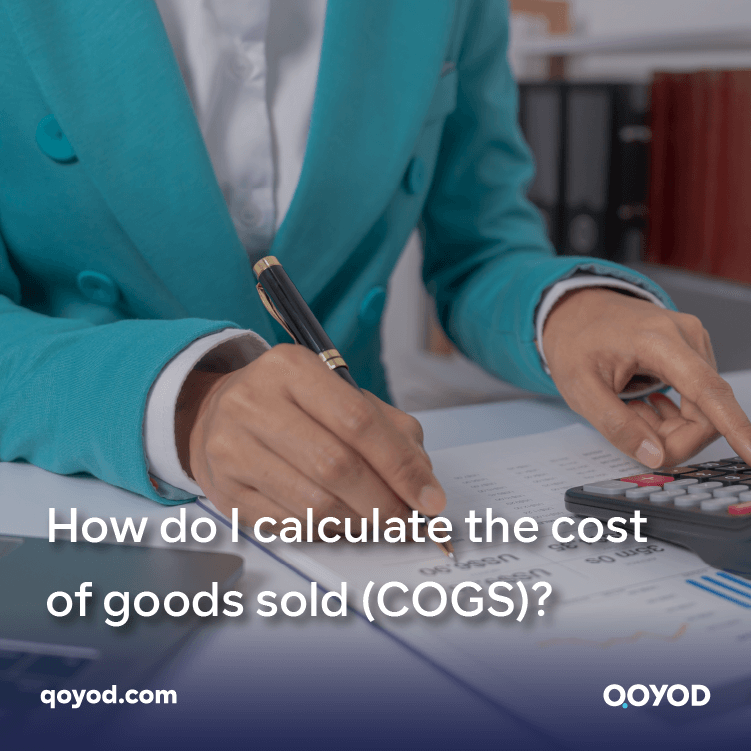Some people may imagine that when the purchase price of the goods is paid, it is only the cost of the goods sold. This perception is completely wrong because many factors intervene in its calculation, and it is considered one of the basic inputs in extracting the result of the establishment’s work. If you would like to know the full description of the cost of goods sold, the methods for calculating it, the most important factors that affect it, and how to manage it effectively, then follow the lines of this article with us.
What is the cost of goods sold?
It is the cost that the establishment bears after completing the purchase process, whether from the supplier or the factory. It includes the costs of purchasing and preparing the goods to be offered for sale. The cost of the goods sold can be divided into the following elements:
- Purchase cost: This is the price paid to the supplier or manufacturer in exchange for obtaining the commodity.
- Shipping and insurance cost: It is related to the expenses of transporting the goods from one place to another, as well as insurance policies on those goods against accidents, burglary, and fire.
- The cost of storage is the expenses associated with storing the goods, including the costs of wrapping and packing, the tools used in storage, labor wages, maintenance, and electricity.
The importance of the cost of goods sold and its impact on the organization’s accounts
As we know, the cost of the goods is deducted from the establishment’s total revenues to determine profit, and its importance lies in the following points:
- Determine profitability accurately, as the cost of goods sold directly affects the total costs of the activity and thus affects profitability.
- Inventory calculation The cost of goods sold affects the inventory calculation; the lower the cost of goods sold, the more this affects storage costs and its components.
- The process of tracking expenses where the product is priced after calculating the cost of goods sold and all other expenses until the product reaches the hands of the final consumer. Any impact on the calculation of the cost of goods sold has a significant impact on other expenses and is called the cost of sales.
- The impact on zakat and tax accounts is that in establishments that are committed to keeping regular accounting records that are reviewed by the bodies concerned with calculating zakat and taxes, the cost of goods sold is one of the basics of the actual inventory of financial transactions within the establishment.
- Through the company’s knowledge of the cost of goods sold, the correct financial decisions are made, and this can go beyond requesting financing from banks and financial institutions in light of those numbers.
- There is a direct impact on the pricing process because the organization is in a perfectly competitive market, so competitors’ prices must be followed, and the final selling price is affected by the net cost of the goods sold.
Accounting treatment for the cost of goods sold
Before entering into the accounting entries used to prove the purchase process and determine the value of the cost of goods sold, it is necessary to know the equation for the cost of goods sold, which we use at the end of the financial year, which is:
Cost of goods sold = inventory value at the beginning of the period + purchases during the period + inventory balance at the end of the period.
Practical example
In this example, we explain how to process the cost of goods sold entry during the period and upon completion of the purchase transaction.
Al-Huda Company purchased goods in the amount of 100,000 Saudi riyals. Shipping and transportation were disbursed in the amount of 1,500 Saudi riyals. The insurance premiums for the goods amounted to 500 Saudi riyals. It is required to calculate the cost of the goods sold and prepare the accounting entries for that case.
Cost of goods sold = value of purchases + value of shipping and handling + value of insurance premiums
500+1500+100000=102 thousand Saudi riyals
Accounting entry
| the date | account name | debt | Credit |
| 12/1 | / Purchases | 100000 | |
| Shipping and transportation costs | 1500 | ||
| /Insurance expense | 500 | ||
| Treasury or bank | 102000 |
Cost of goods sold and accounting treatment in two cases: periodic inventory and perpetual inventory
Before the emergence of specialized financial programs, the periodic inventory method was the most common in determining the cost of goods sold, and the inventory balance was evaluated every three months, six months, or a full year. The cost is calculated according to the previously mentioned equation, which is the cost of goods sold = the beginning balance of the period + purchases minus the end of the period balance. However, in the case of continuous inventory, special transactions on the inventory are recorded, whether buying or selling, so we can take a real-time inventory of the cost of the goods sold.
First: periodic inventory and its accounting treatment
Assuming that the company, when evaluating the inventory at the end of the period, found five cartons of merchandise for 1,000 Saudi riyals per carton, which are recorded in the statement of financial position in the previous year, and that 10 cartons of merchandise were purchased this year for 1,000 Saudi riyals per carton, the accounting entry to prove the transaction will be as follows:
| the date | account name | debt | Credit |
| 12/1 | / Purchases | 10000 | |
| / Suppliers | 10000 |
In continuation of the previous example, 5 cartons were sold for 2000 Saudi riyals. Therefore, the accounting entry for sales will be as follows:
| the date | account name | debt | Credit |
| 30/3 | /customers | 10000 | |
| the sales | 10000 |
With the successive entries, management cannot make an actual count of the inventory without conducting a stocktake. Therefore, the management decided to make an actual stocktake of the total remaining cartons inside the warehouse and found five cartons for 10,000 Saudi riyals. Accordingly, the equation for the cost of goods sold will be as follows:
Beginning balance 5,000 + Purchases 10,000 – End balance 10,000 = 5,000 Saudi riyals. Then the ending inventory entry is recorded as follows:
| the date | account name | debt | Credit |
| 31/12 | Ending inventory | 10000 | |
| / Purchases | 10000 |
Second: the perpetual inventory system
You can monitor inventory in real-time in this accounting style, and thus the entry for proving the purchase of the goods is as follows:
Assuming that the company, when evaluating the inventory at the end of the period, found five cartons of merchandise at a price of 1,000 Saudi riyals per carton, which are recorded in the statement of financial position in the previous year, and that 10 cartons of merchandise were purchased this year at a price of 1,000 Saudi riyals per carton, the accounting entry to prove the transaction will be as follows:
| the date | account name | debt | Credit |
| 31/12 | / inventory | 10000 | |
| / Suppliers | 10000 |
As a continuation of the previous example, the entry for the sale of goods is a compound entry, where the real-time inventory of the inventory is done by deducting the number of cartons of the goods sold, and thus the quantity in the stock will decrease. Five cartons were sold for 2000 Saudi riyals per carton, and the form of the entry is as follows:
| Statement | Credit | debt |
| Customers (closing entry to the customer account if payment is in cash) | 10000 | |
| Cost of sales (closing entry to the income statement) | 5000 | |
| Sales (closing-entry income statement) | 10000 | |
| Inventory (closing balance sheet) | 5000 |
The relationship between the cost of goods sold to the cost of inventory
There is more than one method through which the actual value of inventory is treated, whether the number of existing goods or the value of the existing goods. The policy of each facility differs in evaluating the cost of inventory, and we mention these methods as follows:
- The first-in, first-out method is where the oldest goods are sold in order to avoid rising prices. Therefore, the cost of the goods sold is evaluated on this basis. This method assumes the occurrence of rapid and sudden changes in prices from one period to another.
- The last-in, first-out method is in contrast to the first method, as what comes to the store first is sold in the last. It is not widely used except in specialized cases and negatively affects the cost of the goods sold.
- Average cost method: In this method, a weighted average is created for all the goods in the warehouse, and the value of the goods, regardless of their different prices, is divided by the number of units in the inventory. Therefore, even if the price of the goods increases or decreases, the facility is safe because the evaluation is at the average cost.
What is the difference between the cost of goods sold and the cost of sales?
| Comparison | Cost of goods sold | Sales cost |
| the components | The cost of goods sold includes basic purchasing expenses plus shipping, transportation, storage, labor, and insurance expenses. | A term that includes the cost of goods sold plus advertising expenses, salaries, and all costs associated with revenue |
| the influence | It directly affects the final accounts, but its impact is limited to the goods only and all their expenses. | It has a more comprehensive impact because it includes all expenses related to the cost of goods sold. |
| Common usage | The word cost of goods sold is used more in industrial facilities. | The word cost of sales is used more in commercial establishments. |
Cost of goods sold and income statement
The cost of goods sold appears in the income statement in the second item below the total revenue amount and is subtracted to obtain the gross profit. After that, expenses and other costs are deducted until the net profit is obtained. This can be explained through a practical example, which is an income statement of balances extracted from a company.
| Statement | partial | Total |
| Net sales | 200000 | |
| (-) Cost of goods sold | 70000 | |
| Gross profit | 130000 | |
| Operating expenses General and administrative expenses Selling and marketing expenses | 40000 | |
| 35000 | ||
| 10000 | ||
| Total cost | 85000 | |
| Net profit | 45000 |
Cost of goods sold and trial balance
The cost of goods sold item does not appear in the trial balance directly because it depends on comparing the debit balances with the credit balances, and since the cost of goods sold contains within it several other accounts, such as the purchase price of the goods, which is called the purchases account, and the account for shipping, storage, wrapping, packaging, and wages expenses, All of these accounts, by their nature, appear as debits on the debit side of the trial balance.
Cost of goods sold and chart of accounts
The cost of goods sold is included as an expense in the chart of accounts, and since it is a group item for a group of other expenses, it is treated as if the nature of the account debits all other subaccounts. If the nature of the facility is commercial and not industrial, it appears in the balances of the purchase price of the goods, in addition to other expenses such as shipping, labor, etc. However, if the facility is industrial, the cost of raw materials, direct labor, and indirect industrial costs are added to it.
Cost of goods sold and inventory account
The inventory calculation has a direct impact on the cost of goods sold, as any error in calculating the value of the inventory will affect the calculation of the cost of goods sold. For commercial establishments, the price of purchases is in addition to other expenses such as labor, shipping, and insurance, so that the equation for calculating the cost of goods sold includes the inventory balance at the beginning of the period (the balance in last year’s books) + purchases (the price of purchases during the period) + end-of-period inventory (the valuation of the units in the warehouse). As for industrial facilities, what is called excess inventory is added, which is an increase in production over actual demand, and this will affect the cost of sales in general, and subtracting damaged inventory, which is the number of defective units, from the cost of the defective unit will also affect the increase in the cost of sales.
Conclusion
Here we have completed a detailed presentation of the components and definition of the cost of goods sold, the importance and impact of the cost of goods sold on the final accounts of establishments, and methods of calculating it in more than one way. Finally, a comparison was made to clarify the concept of the cost of goods sold versus the cost of sales. We hope that we have succeeded in presenting this.
Join our inspiring community! Subscribe to our LinkedIn page and Twitter to be the first to know about the latest articles and updates. An opportunity for learning and development in the world of accounting and finance. Don’t miss out, join us today!




